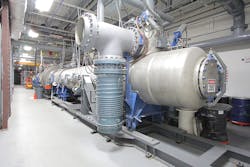Purdue Hypersonics gets Boost With Northrop Grumman Shock Tunnel Donation
Purdue University is pushing forward in hypersonics work with the addition of a Hypersonic Pulse (HYPULSE) shock tunnel to its quickly expanding array of research facilities. The HYPULSE tunnel is a donation from Northrop Grumman Corp. Efforts are underway to disassemble and move the 150-foot-long tunnel from Ronkonkoma, New York to West Lafayette, Indiana. Once installed, Purdue will be only the second university in the U.S. to offer such a hypersonics test capability.
The HYPULSE tunnel will allow flight simulations at speeds ranging from Mach 5 to as high as Mach 40. At Mach 9, a plane can travel from Washington, D.C., to California in just 15 minutes. A conventional plane leaving Washington, D.C,. could reach Virginia, Maryland, and only parts of neighboring states in the same time. Collecting data at higher Mach numbers is critical to extending the understanding of flow physics, especially heat transfer and flight control effectiveness. Defense leaders report that U.S. hypersonics investment has grown dramatically.
Purdue has one of the most comprehensive hypersonics research capabilities in the country, with nearly 40 world-renowned researchers in hypersonics, with expertise in navigation, aerodynamics, aerothermal effects propulsion, autonomy, system engineering, high-temperature materials, and manufacturing. Earlier in 2020, Purdue University was awarded an Air Force contract to develop the first quiet Mach 8 quiet wind tunnel in the world. Purdue’s capabilities add to Indiana’s research in related fields, including the University of Notre Dame’s research in aerodynamic effects, Indiana University’s advanced computing and hypersonic modeling and simulation research, and the Naval Surface Warfare Center, Crane Division’s engineering, testing, and modeling capabilities.
Shock tunnels like HYPULSE start with a reservoir of air at high pressure and high temperature. A shock wave is used to shoot the air through a nozzle at high speeds, reaching temperatures as much as 8,000 degrees Kelvin. It allows tests ranging from a thousandth of a second to the longest, a hundredth of a second. The high-speed tests recreate high-speed flight scenarios such as space craft re-entry or missile flight through the atmosphere as well as replicating unique engine conditions for extremely high-speed propulsion.
School of Aeronautics and Astronautics faculty are tasked with planning aerodynamics and propulsion testing programs that will use the extreme test conditions that HYPULSE can create. Joseph Jewell, an assistant professor, will focus on aerodynamics testing programs, and Carson Slabaugh, also an assistant professor, will work with propulsion projects. Hypersonic defense abilities are considered “game-changing” technologies. With systems that can travel at speeds of Mach 5 or faster and are highly maneuverable, hypersonics are potentially very effective against heavily defended areas.
Prior to Purdue, the HYPULSE shock tunnel has seen its share of history, being used by NASA for the space shuttle heat shield and the U.S. Air Force for design of its X-43 scram jet design, which set several air-speed records. With 40 researchers and long-held collaborations with the National Defense Industrial Association, Purdue is establishing itself as a hypersonics hub that benefits the country in both research and development. In July 2019, Purdue hosted the inaugural NDIA Hypersonics Capabilities Conference, which brought military, government, congressional, industry and policy leaders to further advance U.S. hypersonic systems.
